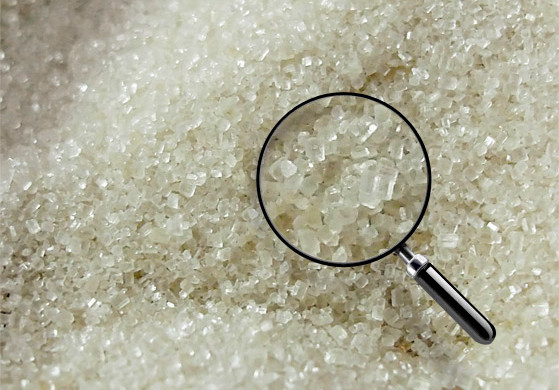A recurring statement that I see in the popular press and in non-scientist-written dietary guidelines is that “sugar is toxic.” As the author of a professionally published textbook on the Mediterranean Diet, I would like to tackle the topics of sugars and carbohydrates in a series of short articles for you. I hope to demystify the topic and show you that although sugars are not “toxic,” American’s escalating intake of simple sugars including traditional sugar and the newer high fructose corn syrup has contributed to poor heath and our obesity epidemic. The information I will share is based on the best scientific information available and will summarize the totality of the literature and expert body statements. This is opposed to simply giving you my opinion or summarizing a single study that seemingly upends all that has come before.
First, I want to talk about a meal’s energy density and the effects that has on one’s weight. Energy density is defined as the total amount of calories per unit of weight in a meal. Numerous studies have shown that if one consumes a diet that includes a large amount of simple sugars and highly processed and refined carbohydrates, then one will consume a higher total number of calories at each meal and gain substantially more weight than someone who minimizes intake of simple sugars and eats mostly unrefined, whole food and whole grain carbohydrate sources (think a whole apple or orange over a glass of apple or orange juice and think whole grain bread versus white bread).
Since we know high energy density foods lead to poor appetite control, it is comforting to know that the opposite is also true—low energy density, carbohydrate rich foods such as vegetables, whole fruits, and whole fiber/whole grain containing foods make one feel more full at a lower calorie consumed level. Thus, one consumes fewer calories when whole foods without added sugars are a significant component of most meals. Have that serving of fruits or veggies with every meal.
An interesting set of studies have shown that decreasing the energy density of common meals such as pasta and baked goods will reduce total calories consumed when these foods are served. This can be done by simple techniques such as using whole-wheat pasta, adding pureed vegetables to the pasta sauces, or adding pureed fruits to the baked goods. There are many good recipes on line that incorporate such techniques, and I have several in my book as well.
One last area to address in this first article is liquid sugars in sweetened beverages and juices. There has been a tremendous increase in the daily amount of calories that Americans consume from beverages. The most common of these are sodas, sports drinks, and fruit juices. In the 1970’s, we took in about 12% of our total calories from beverages while today we take in about 21% in drink form. This equates to around 220 calories per day per person and, over a several year period of time, it is enough calories to add about 20 pounds of fat mass to each and every one of us. Thus, a very simple, inexpensive way to lose weight and keep yourself and your family from gaining excess fat mass is to increase the energy density of meals by predominately consuming whole foods without added sugars and by eliminating sweetened beverages. Water with a squeeze of lemon or lime tastes and is a simple solution to the liquid calorie issue.
I will go deeper into carbohydrates (including simple sugars) and effects on weight and health in several articles to follow.
Dr. Eric Zacharias
Below are the principal references I have used for this article:
- Dietary Guidelines for Americans Committee: U.S. Department of Agriculture. Center for l/Nutrition Policy and Promotion. Dietary guidelines for Americans, 20 I 0. http://www.cnpp.usda.gov/dictaryguidelines.htm. Accessed l Jan 2011.
- Wang Y, Beydoun MA, Liang L. Caballero B. Kumanyika SK. Will all Americans become overweight or obese? Estimating the progression and cost of the US obesity epidemic. Obesity (Silver Spring). 2008; 16(10):2323-30.
- Duffey KJ. Gordon-Larsen P, Jacobs Jr DR, Williams OD. Popkin BM. Differential associations of fast food and restaurant food consumption with 3-y change in body mass index: the Coronary Artery Risk Devclopmem in Young Adults Study. Am J Clin Nutr. 2007;85( I): 201-8.
- Erlanson-Albertsson C. How palatable food disrupts appetite regulation. Basic Clin Pharrnacol ?Toxicol. 2005;97(2):61-73.
- Rolls BJ. The relationship between dietary energy density and energy intake. Physiol Behav. l./ 2009;97(5):609-15.
- Ledikwe JH, Rolls BJ, Smiciklas-Wright H, Mitchell DC, Ard JD, Champagne C, Karanja N, Vun PH, Stevens VJ, Appel LJ. Reductions in dietary energy density are associated with weight loss in overweight and obese participants in the PREMIER trial. Am J Clin Nutr. 2007;85(5): 1212-21.
- Savage JS, Marini M, Birch LL. Dietary energy density predicts women’s weight change over ? y. Am J Clin Nutr. 2008;88(3):677-84.
- Schroder H. Protective mechanisms of the Mediterranean diet in obesity and type 2 diabetes. ? Nutr Biochem. 2007; 18(3): 149-60.
- Blatt AD, increase Roe LS, vegetable Rolls intake BJ. in Hidden adults. Am vegetables: J Clin an Nutr. effective 2011 strategy ;93(4):756-63. to reduce energy intake
- National Cancer Institute. Usual dietary intakes: food intakes, US population. 2004-2010. http://riskfactor.cancer.gov/diet/usualintakes/pop/.

